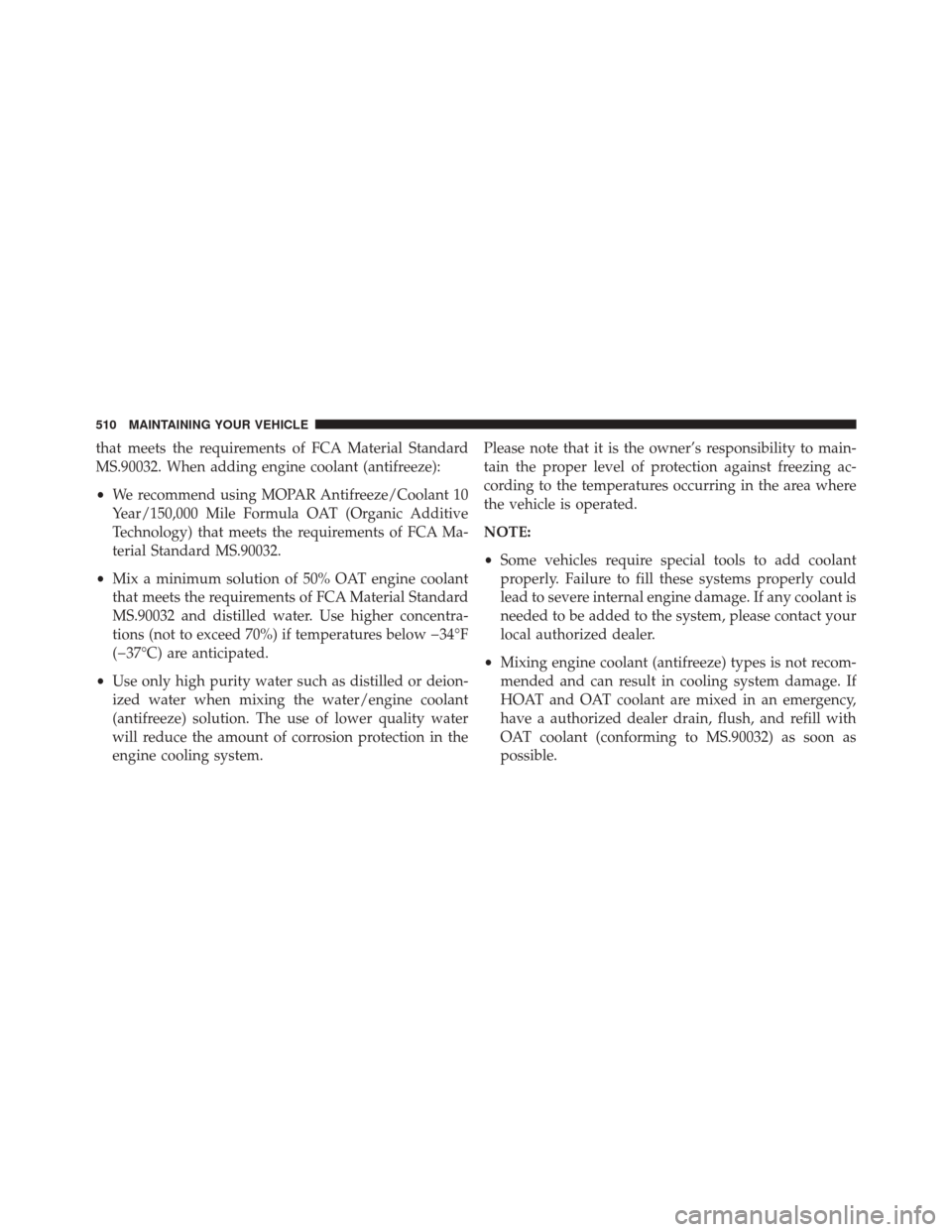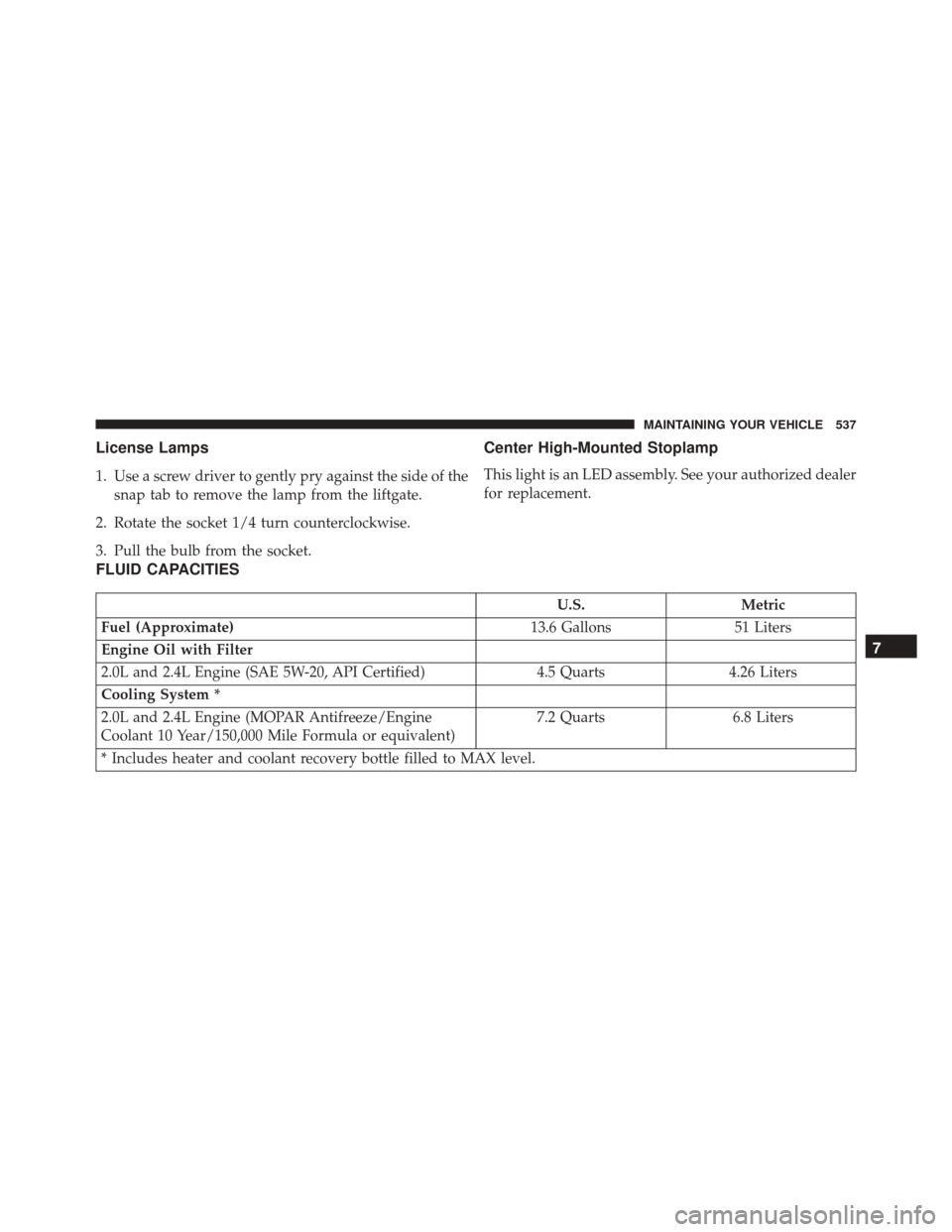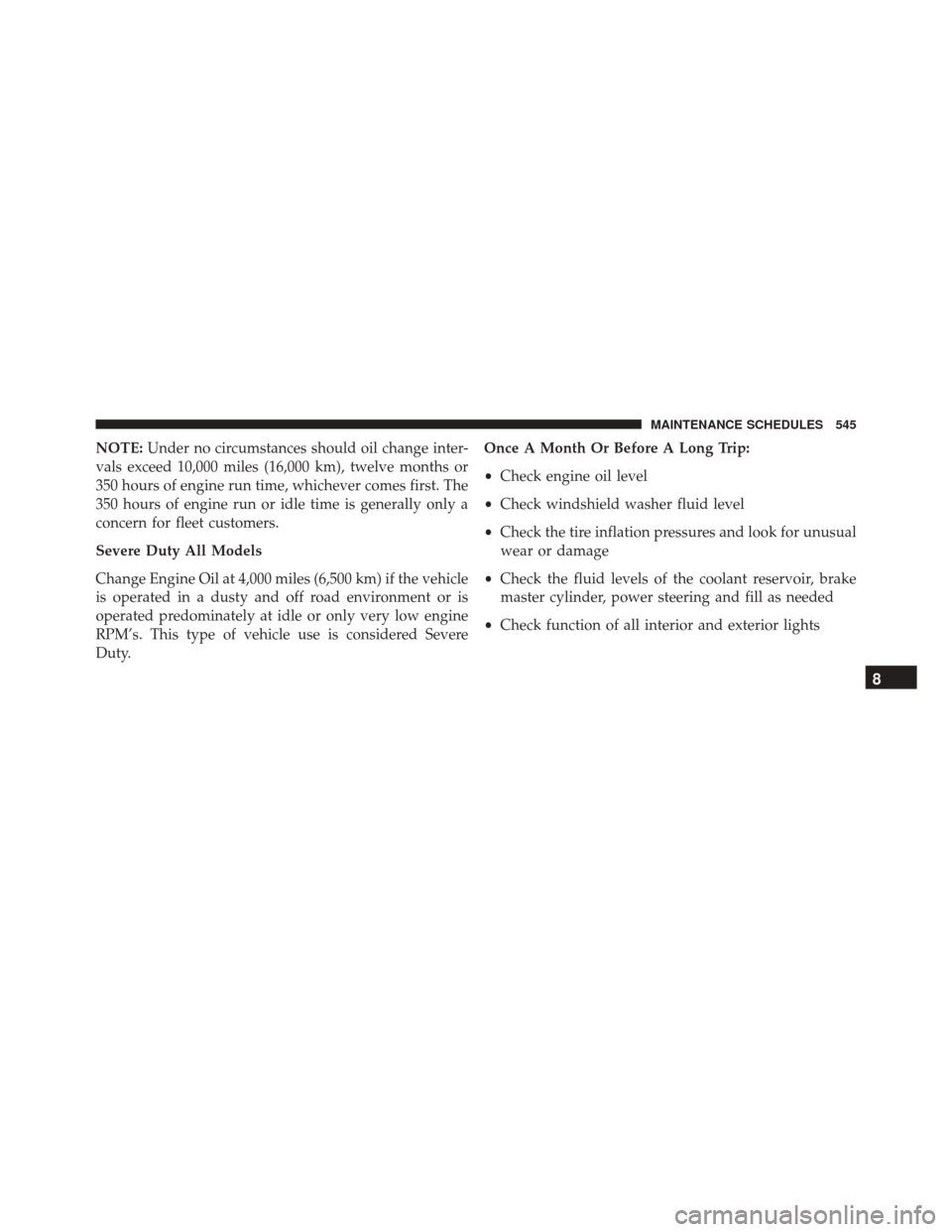2016 JEEP PATRIOT coolant level
[x] Cancel search: coolant levelPage 328 of 587

•Extended use of recirculation may cause the windows
to fog. If the interior of the windows begins to fog,
push the Recirculation button to return to outside air.
Some temp/humidity conditions will cause captured
interior air to condense on windows and hamper
visibility. For this reason, the system will not allow
Recirculation to be selected while in defrost mode.
Attempting to use the recirculation while in these
modes will cause the LED in the control button to blink
and then turn off.
• Most of the time, when in Automatic Operation, you
can temporarily put the system into Recirculation
Mode by pushing the Recirculation button. However,
under certain conditions, while in Automatic Mode,
the system is blowing air out the defrost vents. When
these conditions are present, and the Recirculation
button is pushed, the indicator will flash and then turn
off. This tells you that you are unable to go into
Recirculation Mode at this time. If you would like the system to go into Recirculation Mode, you must first
move the Mode knob to Panel, Bi-Level, Mix, or Floor
and then push the Recirculation button. This feature
reduces the possibility of window fogging.
Operating Tips
NOTE:
Refer to the chart at the end of this section for
suggested control settings for various weather condi-
tions.
Summer Operation
The engine cooling system must be protected with a
high-quality antifreeze coolant to provide proper corro-
sion protection and to protect against engine overheating.
A solution of 50% OAT (Organic Additive Technology)
coolant that meets the requirements of FCA Material
326 UNDERSTANDING YOUR INSTRUMENT PANEL
Page 512 of 587

that meets the requirements of FCA Material Standard
MS.90032. When adding engine coolant (antifreeze):
•We recommend using MOPAR Antifreeze/Coolant 10
Year/150,000 Mile Formula OAT (Organic Additive
Technology) that meets the requirements of FCA Ma-
terial Standard MS.90032.
• Mix a minimum solution of 50% OAT engine coolant
that meets the requirements of FCA Material Standard
MS.90032 and distilled water. Use higher concentra-
tions (not to exceed 70%) if temperatures below �34°F
(�37°C) are anticipated.
• Use only high purity water such as distilled or deion-
ized water when mixing the water/engine coolant
(antifreeze) solution. The use of lower quality water
will reduce the amount of corrosion protection in the
engine cooling system. Please note that it is the owner’s responsibility to main-
tain the proper level of protection against freezing ac-
cording to the temperatures occurring in the area where
the vehicle is operated.
NOTE:
•
Some vehicles require special tools to add coolant
properly. Failure to fill these systems properly could
lead to severe internal engine damage. If any coolant is
needed to be added to the system, please contact your
local authorized dealer.
• Mixing engine coolant (antifreeze) types is not recom-
mended and can result in cooling system damage. If
HOAT and OAT coolant are mixed in an emergency,
have a authorized dealer drain, flush, and refill with
OAT coolant (conforming to MS.90032) as soon as
possible.
510 MAINTAINING YOUR VEHICLE
Page 514 of 587

Coolant Level
The coolant bottle provides a quick visual method for
determining that the coolant level is adequate. With the
engine idling and warm to normal operating tempera-
ture, the level of the engine coolant (antifreeze) in the
bottle should be between the “ADD” and “FULL” lines
shown on the bottle.
The radiator normally remains completely full, so there is
no need to remove the radiator cap unless checking for
the coolant freeze point or replacing the engine coolant
(antifreeze). Advise your service attendant of this. As
long as the engine operating temperature is satisfactory,
the coolant bottle need only be checked once a month.
When additional engine coolant (antifreeze) is needed to
maintain the proper level, it should be added to the
coolant bottle. Do not overfill.
Points To Remember
NOTE:When the vehicle is stopped after a few miles/
kilometers of operation, you may observe vapor coming
from the front of the engine compartment. This is nor-
mally a result of moisture from rain, snow, or high
humidity accumulating on the radiator and being vapor-
ized when the thermostat opens, allowing hot engine
coolant (antifreeze) to enter the radiator.
If an examination of your engine compartment shows no
evidence of radiator or hose leaks, the vehicle may be
safely driven. The vapor will soon dissipate.
• Do not overfill the coolant expansion bottle.
•
Check the coolant freeze point in the radiator and in the
coolant expansion bottle. If engine coolant (antifreeze)
needs to be added, the contents of the coolant expansion
bottle must also be protected against freezing.
512 MAINTAINING YOUR VEHICLE
Page 539 of 587

License Lamps
1. Use a screw driver to gently pry against the side of thesnap tab to remove the lamp from the liftgate.
2. Rotate the socket 1/4 turn counterclockwise.
3. Pull the bulb from the socket.
Center High-Mounted Stoplamp
This light is an LED assembly. See your authorized dealer
for replacement.
FLUID CAPACITIES
U.S. Metric
Fuel (Approximate) 13.6 Gallons51 Liters
Engine Oil with Filter
2.0L and 2.4L Engine (SAE 5W-20, API Certified) 4.5 Quarts4.26 Liters
Cooling System *
2.0L and 2.4L Engine (MOPAR Antifreeze/Engine
Coolant 10 Year/150,000 Mile Formula or equivalent) 7.2 Quarts
6.8 Liters
* Includes heater and coolant recovery bottle filled to MAX level.
7
MAINTAINING YOUR VEHICLE 537
Page 547 of 587

NOTE:Under no circumstances should oil change inter-
vals exceed 10,000 miles (16,000 km), twelve months or
350 hours of engine run time, whichever comes first. The
350 hours of engine run or idle time is generally only a
concern for fleet customers.
Severe Duty All Models
Change Engine Oil at 4,000 miles (6,500 km) if the vehicle
is operated in a dusty and off road environment or is
operated predominately at idle or only very low engine
RPM’s. This type of vehicle use is considered Severe
Duty. Once A Month Or Before A Long Trip:
•
Check engine oil level
• Check windshield washer fluid level
• Check the tire inflation pressures and look for unusual
wear or damage
• Check the fluid levels of the coolant reservoir, brake
master cylinder, power steering and fill as needed
• Check function of all interior and exterior lights
8
MAINTENANCE SCHEDULES 545
Page 569 of 587

Installing Child Restraints Using The Vehicle Seat
Belt..................................90
Lower Anchors And Tethers For Children .......82
Older Children And Child Restraints ..........78
Seating Positions ........................81
Child Safety Locks .........................34
Clean Air Gasoline ....................... .424
Cleaning Wheels .............................. .524
Climate Control ......................... .316
Clock .......................... .262, 282, 291
Clutch ................................ .514
Clutch Fluid ............................ .514
Coin Holder ............................ .202
Cold Weather Operation ....................337
Compact Disc (CD) Maintenance ..............315
Compact Spare Tire ....................... .407
Compass .............................. .246
Compass Calibration ...................... .258Compass Variance
........................ .258
Connector UCI................................ .306
Universal Consumer Interface (UCI) ..........306
Console ............................... .202
Contract, Service ......................... .557
Coolant (Antifreeze) ...................... .537
Coolant Pressure Cap (Radiator Cap) ...........511
Cooling System .......................... .507
Adding Coolant (Antifreeze) ...............509
Coolant Level ..................... .507, 512
Disposal Of Used Coolant .................511
Drain, Flush, And Refill ...................508
Inspection ........................... .512
Points To Remember .....................512
Pressure Cap ..........................511
Radiator Cap ..........................511
Selection Of Coolant (Antifreeze) .........508, 538
Corrosion Protection ...................... .521
10
INDEX 567
Page 571 of 587

Emergency, In Case OfJacking .............................. .454
Jump Starting ......................... .475
Towing ............................. .482
Emission Control System Maintenance ..........492
Engine ............................. .489, 490
Air Cleaner .......................... .499
Block Heater ......................... .338
Break-In Recommendations .................96
Checking Oil Level ..................... .495
Coolant (Antifreeze) ..................507, 538
Cooling ............................. .507
Exhaust Gas Caution ..................98, 428
Fuel Requirements ..................... .424
Jump Starting ......................... .475
Oil .......................... .495, 537, 538
Oil Filler Cap ...................489, 490, 497
Oil Filter ............................ .498
Oil Selection .......................... .496Oil Synthetic
......................... .498
Overheating .......................... .451
Enhanced Accident Response Feature ............70
Ethanol ............................... .425
Event Data Recorder ........................74
Exhaust Gas Caution ....................98, 428
Exhaust System ....................... .98, 505
Exterior Lights .......................... .101
Filters Air Cleaner .......................... .499
Air Conditioning ....................328, 502
Engine Oil ........................ .498, 538
Engine Oil Disposal .....................498
Flashers ............................... .451
Hazard Warning ....................... .451
Turn Signal .....................101, 243, 536
Flooded Engine Starting ....................337
Fluid, Brake ............................ .540
10
INDEX 569